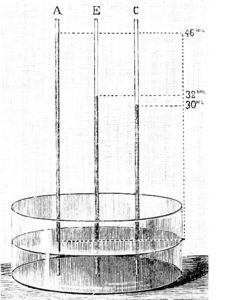Capillary Action

Capillary action is the tendency of a liquid to rise in narrow tubes or to be drawn into small openings such as those between grains of a rock. Capillary action, also known as capillarity, is a result of the intermolecular attraction within the liquid and solid materials. A familiar example of capillary action is the tendency of a dry paper towel to absorb a liquid by drawing it into the narrow openings between the fibers.
The mutual attractive force that exists between like molecules of a particular liquid is called cohesion. This force is responsible for holding a raindrop together as a single unit. Cohesion produces the phenomenon known as surface tension, which may allow objects that are more dense than the liquid to be supported on the surface of the liquid without sinking. When an attractive force exists between two unlike materials, such as a liquid and a solid container, the attractive force is known as adhesion. Adhesion is the force that causes water to stick to the inside of a glass. If the adhesive force between the liquid and solid is greater than the cohesive force within the liquid, the liquid is said to wet the surface and the surface of the liquid near the edge of the container will curve upward. In cases where the cohesive force is greater than adhesion, the liquid is said to be nonwetting and the liquid surface will curve downward near the edge of the container.
The combination of the adhesive forces and the surface tension that arises from cohesion produces the characteristic upward curve in a wetting fluid. Capillarity is the result of cohesion of water molecules and adhesion of those molecules to the solid material forming the void. As the edges of the container are brought closer together, such as in a very narrow tube, the interaction of these phenomena causes the liquid to be drawn upward in the tube. The more narrow the tube, the greater the rise of the liquid. Greater surface tension and increased ratio of adhesion to cohesion also result in greater rise. However, increased density of the liquid will cause it to rise to a lesser degree.
The force with which water is held by capillary action varies with the quantity of water being held. Water entering a natural void, such as a pore within the soil, forms a film on the surface of the material surrounding the pore. The adhesion of the water molecules nearest the solid material is greatest. As water is added to the pore, the thickness of the film increases, the capillary force is reduced in magnitude, and water molecules on the outer portion of the film may begin to flow under the influence of gravity. As more water enters the pore the capillary force is reduced to zero when the pore is saturated. The movement of groundwater through the soil zone is controlled, in part, by capillary action. The transport of fluids within plants is also an example of capillary action. As the plant releases water from its leaves, water is drawn upward from the roots to replace it.
Additional topics
Science EncyclopediaScience & Philosophy: Calcium Sulfate to Categorical imperative